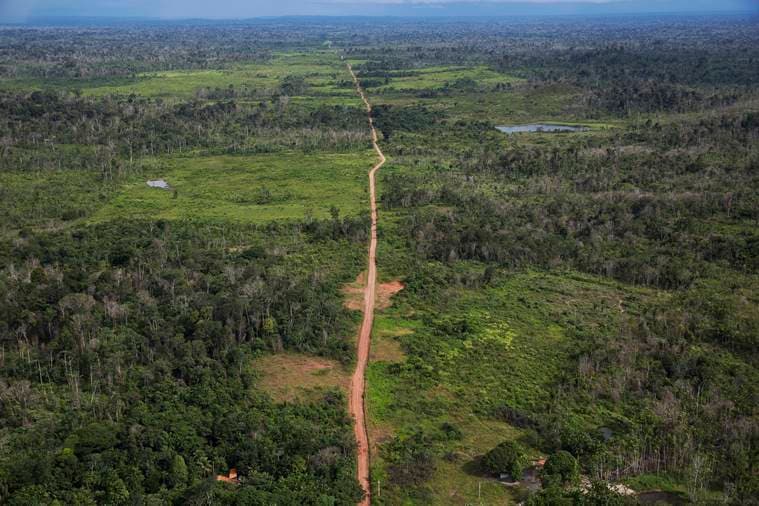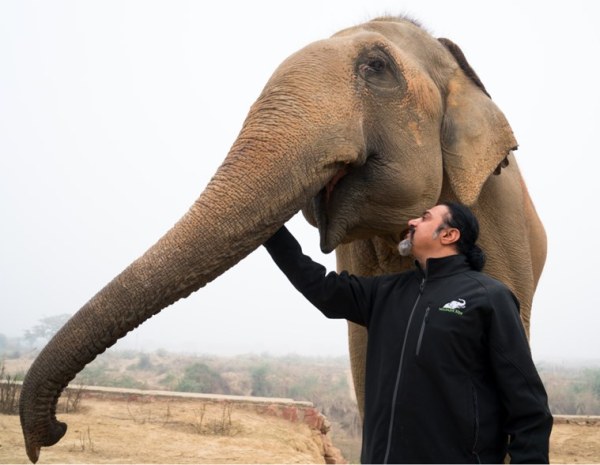 FILE — An aerial view of a deforested area from a helicopter carrying members of the Specialized Inspection Group, a part of Brazil’s environmental protection agency called Ibama, in the state of Maranhao in Brazil, March 24, 2017. Cutting down trees at the current rate in the Amazon could lead to runaway deforestation, environmentalists say. (Lalo de Almeida/The New York Times)
FILE — An aerial view of a deforested area from a helicopter carrying members of the Specialized Inspection Group, a part of Brazil’s environmental protection agency called Ibama, in the state of Maranhao in Brazil, March 24, 2017. Cutting down trees at the current rate in the Amazon could lead to runaway deforestation, environmentalists say. (Lalo de Almeida/The New York Times)
As coronavirus sweeps across the globe infecting millions in its wake, it lays bare an oft-repeated but disregarded linkage emphasised by scientists: climate change, biodiversity loss, and outbreak of newly-discovered diseases are interconnected. The humanitarian threats we face today – global warming, rise in ocean temperatures, human-wildlife conflict, extreme heat and flood situations – are a direct result of disproportionate human activity. “This is a global wake up call,” says co-founder and CEO of Wildlife SOS Kartick Satyanarayan.
The pandemic, in that sense, is a clear warning that humanity is placing way too many pressures on the natural ecosystem than it can cope with.
In an interview to indianexpress.com, Satyanarayan talks about coronavirus and its impact on humans and wildlife, and how lockdown is a time to re-evaluate human relations with nature.
Excerpts from the interview:
Q. Viral pandemics tell us how closely human health is connected to the health of natural ecosystems. As our interaction with wildlife grows, a closer understanding of these viruses will help us reduce their pandemic potential. Have human practices led to the Covid-19 situation?
A. As we try to understand the patterns of rising illnesses through the past decades and compare them to the Covid-19 pandemic, we come to an enlightening realisation: It’s believed that coronavirus has one thing in common with diseases like Ebola, SARS, Nipah – they originated in markets and from exploitation of wild animals. Covid-19 is also believed to have emerged from a wild animal market in Wuhan, indicating that a wild animal was possibly a part of the cycle before the mutated virus infected humans. Research indicates that pandemics are on the rise as negative interaction with wildlife increases and this is happening only because humans no longer respect the need to give wild animals the space they need.
Burgeoning wildlife trade, consumption of bush meat, rapid expansion of agricultural pursuits into forested tracts have brought humans and wild animals into closer contact than ever before, thus creating ideal situations for unfamiliar illnesses to emerge for which the human body has had no time to develop a defence system against these organisms.
All of this increases chances of dangerous diseases which most nations may not have the resources to battle. This is a global wakeup call.
Also Read | Why wildlife consumption became popular in China
Q. In the past month, and due to the lockdown, social media has been replete with images of nature recharging itself, and the before and after pictures of global emission levels have been stark. This lockdown has really given us time to introspect about our relationship with nature.
A. The lockdown is, indeed, a time for introspection. It is a time to question many of our supposed “entertainment” through wildlife such as riding or performing circuses, allowing the use of wild animals like pangolins, bears, bats, tigers etc for traditional medicine thus encouraging illegal poaching of many endangered species. We need to examine the ethics behind these practices and their direct impact on human health and the earth’s natural ecosystems. We must learn to redefine co-existence and the fact that the neighbours we must learn to get along with are not only other humans but also the trees, animals and all the elements that exist. We must learn to see them as gifts of Mother nature and observe what they bring to our lives, instead of thinking of them as competitors for nature’s resources, space and food or worse still as something to be manipulated, exploited and utilised.
Explained: Who was June Almeida, the virologist who first saw the coronavirus?
Q. You have spent years safeguarding the delicate balance between human-wildlife coexistence. And now, the pandemic is posing a challenge to this very coexistence. As a conservationist, what are your challenges?
A. As a conservationist, the challenge we face is to make sure the lessons we are learning in this crisis actually give birth to permanent policy decisions. As a conservation organisation, we plan for contingencies, and we are prepared for natural disasters like floods, fires and other fortuities, but the nationwide lockdown is something we haven’t experienced in our lifetime and came as a shock for us. With businesses shut down, and considering the massive amounts of food consumed at our centres across the country every day, this sudden constriction of resources took some time to manage. Our rescuers are still continuing on their daily operation with dedication and it’s encouraging to see that.
 Co-founder and CEO of Wildlife SOS Kartick Satyanarayan.
Co-founder and CEO of Wildlife SOS Kartick Satyanarayan.
Q. What are some of the ongoing/future projects to conserve wildlife in India and what’s your role in those?
A. Wildlife SOS is currently involved in many conservation projects. Our Elephant Rehabilitation Project aims at freeing captive elephants from the exploitative existence they lead, while our Bear Rehabilitation and Leopard rehabilitation projects take care of sloth bears and leopards found in man-animal conflict situations, or from the ‘Dancing Bear’ activity.
In the meantime, our rescue teams continue on their daily rescue operations despite the lockdown, putting their own lives at risk to ensure no call for aid goes unanswered. Our Refuse to Ride Campaign is an awareness campaign to help people understand how elephants are trained to give rides to tourists. Moving forward, we plan to strengthen our efforts to prevent illegal wildlife poaching and trade. We also have plans to develop and implement sustainable solutions for mitigating human-wildlife conflict situations in the country.
Also Read our interview of Nat Geo explorer Heather Koldewey on plastic pollution
Q. Lot of us look to nature for inspiration on a daily basis, but this lockdown, just like any adverse situation, has made us realise that conserving natural systems is in our best interests. How can we keep connected to nature in these trying times?
A. I started working with nature and wildlife at a very young age, and that has always taught me the importance of a balance between all the species inhabiting this planet. Working with animals doesn’t need much, just a sense of caring for nature around us. You can volunteer with wildlife organisations, animal shelters, rescue centers and develop a deeper sense of compassion. At this time, many shelters would be very grateful if individuals took up fostering. It will reduce the resource crunch they are currently facing, and ensure that the animal fostered by you receives the best care possible at this time.
I still feel a deep sense of gratitude when I find a child has worked hard to save a baby bird or a tiny squirrel; or a man tired after a day’s work still finds it in his heart to pick up an injured bird or bat and brings it to us for care and shelter. However, these are individual acts of compassionate conservation. The key word in your questions is “natural systems” ecosystems in fact. To protect that a lot of us have to work together and our protection as a country has to be directed towards that. The question is what are we giving back to nature? So volunteering at wildlife rescue centers, animal shelters, helping to plant trees, protect forests, putting compost back in the soil, helping to conserve water could be the things that could help us stay connected with nature.
Q. Tell us about your Earth Day special film. What is the message you want to give to your audience, given the circumstances?
A. The film Earth@Home is one-of-its-kind documentary interwoven together using self-shot footage of National Geographic experts, including myself, from different corners of the world, produced entirely from home. It highlights the delicate connection between human actions and nature, and the lessons we can draw from this unprecedented pandemic situation. As this disease is rooted within the animal kingdom and originates from the loss of the buffer between man and wildlife, this film talks about the need to re-evaluate our relationship with nature. The current global pause on commercialism also gives us a chance to reflect on that relationship. This is the message we hope to convey.
The film will premiere on the 50th anniversary of Earth Day, April 22 at 7 pm on National Geographic.